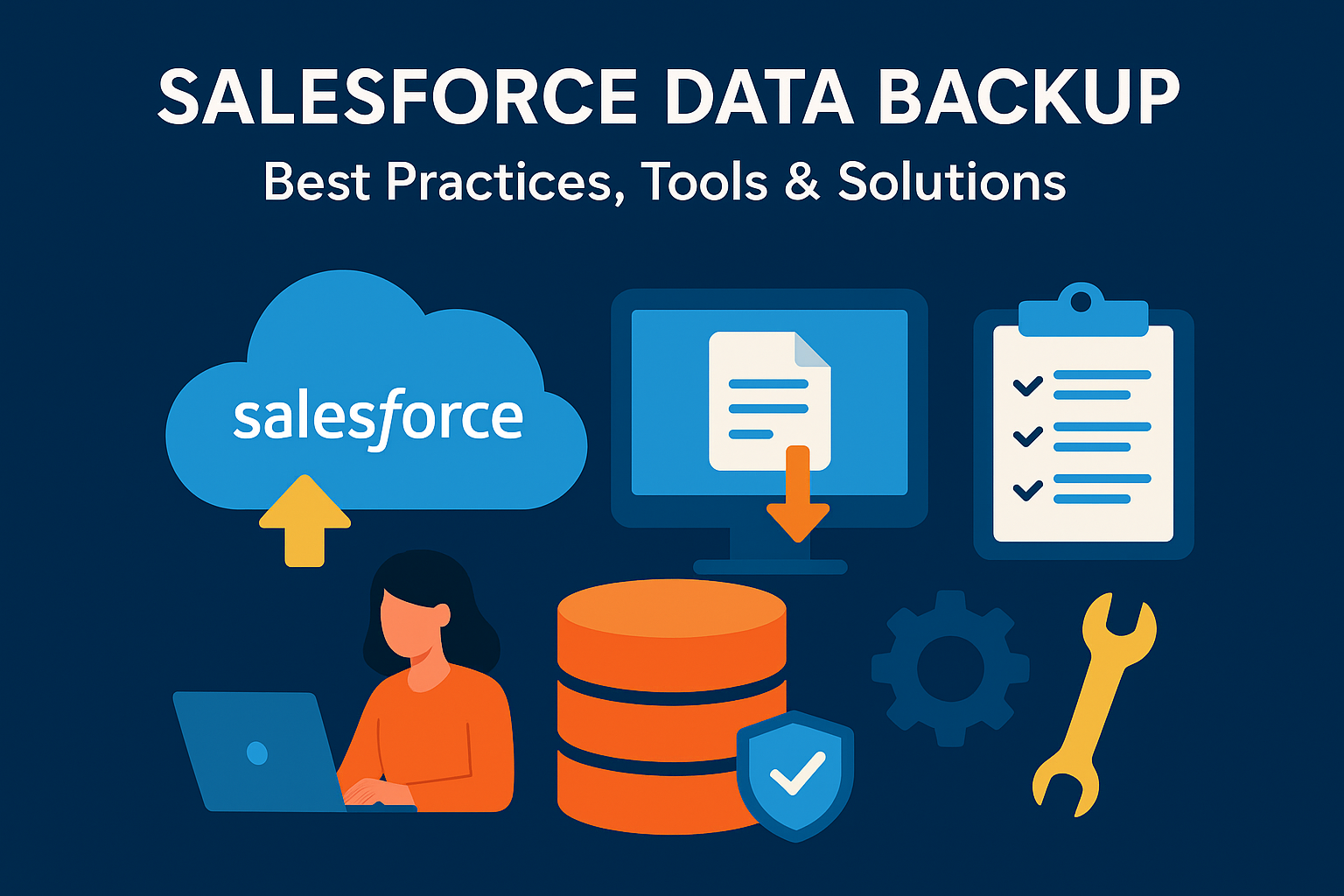Salesforce Data Backup: Best Practices, Tools & Solutions

In the data-driven business world of today, your customer relationship management (CRM) platform is the pulse of your business. For most of the world’s millions of businesses, that pulse is Salesforce. It stores your most valuable asset: customer information. From sales opportunities and account records to marketing efforts and customer service requests, all this information is the basis of your business insights and strategic actions.
But what if all of a sudden that data is lost? This is not some hypothetical fear tactic; data loss is a real and constant danger. This in-depth guide will take you through the basics of Salesforce data backup, covering the dangers, best practices, top tools, and methods you must put into place in order to make sure your business is always secure.
Table of Contents
Introduction to Salesforce Data Backup
Why Data Backup Is Necessary for Salesforce Users
Most companies are under the false assumption: “Our data is in the cloud, so Salesforce takes care of backup and recovery automatically.” This is a fatal flaw. Although Salesforce has an extremely reliable and secure platform, their Shared Responsibility Model spells out that while they will cover infrastructure security and availability, you are on the hook for your own data. This involves storing it, maintaining its integrity, and having the capacity to recover it when lost.
Common Challenges in Managing Salesforce Data
The sales for the atmosphere are dynamic and versatile. Data is constantly created, modified, and deleted by many users. This presents a number of challenges in terms of management, such as monitoring changes in thousands of records, managing complex object relationships, and making sure that backup maintains not only data but also metadata (custom fields, page layouts, and code) that provides data with reference and purpose.
Understanding Salesforce Data Loss Risks
The loss of Salesforce data is rarely as a result of the catastrophic failure of the platform; it is more commonly the result of more physical but equally weak events.
1. Accidental deletion of records:
A well-intentioned employee can delete the key report, personal records, or even thousands of records using a buggy report or data loader process by mistake. Without a fine-grained backup, recovery from this is impossible.
2. Compilation errors and API overwrites:
Salesforce is often not used in isolation. It connects with ERP, accounting, and marketing automation systems. A sync error or faulty API call can overwrite a wide bridge of good data with bad data in minutes.
3. Data corruption and security events:
Cyber attacks from contaminated internal or outside sources, i.e.,The recent backup is your only guaranteed way without taking a ransom.
4. Compliance and audit issues:
Laws such as GDPR, HIPAA, and SOX order companies to prove their data, such as the ability to restore and audit old records. Lack of compliance can lead to enormous penalties and legal proceedings.
Native Backup Features in Salesforce
Salesforce does provide some native features, but with extraordinary limitations.
1. Salesforce Data Export Service:
This enables you to manually schedule weekly or monthly exports of your data as .csv files, packaged into a ZIP file. This is a time-consuming, laborious process that does not include your metadata and takes much effort to decode and restore.
2. Salesforce Backup & Restore Tool:
A paid add-on (offered in Performance, Unlimited, and Enterprise Editions) that offers more automated data and metadata backups. It’s an upgrade from the manual export but still has limitations versus third-party experts.
3. Limitations of In-Built Salesforce Backup Features:
The fundamental limitations are an absence of granularity (difficult to restore one record), backup schedules that are infrequent, restoration processes that are complicated and time-consuming, and a deficiency of point-in-time recovery features to roll back to a point prior to corruption of data.
Best Practices for Salesforce Data Backup
A good backup strategy is more than just choosing a tool. It’s about a systemic approach.
1. Create a well-defined backup strategy:
Record what data you have, who owns it, and how important it is to the business (RPO—Recovery Point Objective and RTO—Recovery Time Objective).
2. Select the correct backup frequency:
Sensitive data needs to be backed up frequently or several times a day. Less changing data can be backed up daily or weekly. Manual exports are not enough for today’s businesses.
3. Data encryption and security guarantee:
Your backup replicas should be encrypted during flying and resting. Make sure your backup service provider. O. C. 2 and I. S. O. Subject to leading security standards like 27001.
4. Implement the Data Recovery Test:
Backup is not very useful if you can’t recover from it. Regular automatic recovery tests to validate the integrity of your backup and the ability to restore your employees.
5. Compliance with industry rules:
Choose the solution that enables you to achieve compliance needs with abilities such as automated retention policies, audit logs, and the ability to generate reports for auditors.ou to achieve compliance requirements with capabilities such as automated retention policies, audit logs, and the capability to generate reports for auditors.
Top Salesforce Data Backup Solutions & Tools
This is where third-party vendors come in, which provide automatic, granular, and easy backups and recovery.
1. Overview of popular third-party backup suppliers:
These dedicated utilities provide full automation and back up your full sales force ORG (data, metadata, and connections) several times a day.
2. The main features for finding:
View for automated daily back See automatic daily backup, fine-grained search-and-restore features, strong security, sandbox seeding, and pre-restore preview to prevent good data from being rewritten.ata.
Comparison of Popular Suppliers
1. OwnBackup:
A leader in the market for robust automation, fine-grained recovery, and world-class data archiving and sandbox seeding capabilities. Robust Security and Compliance Focus.
2. Spanning Backup:
Famous for its set-and-forget, easy-to-use interface. Provides Dependable Automated Daily Backups and Straightforward, Point-And-Click Restoration for Admins.
3. Druva:
Offers an end-to-end data resilience platform that very much comes as part of an umbrella offering for class data protection, targeting enterprises with complicated requirements.
4. Odaseva:
Targeted at large-scale enterprises with complicated Salesforce environments (particularly those with demanding GDPR requests). Offers sophisticated orchestration, data governance, and compliance capabilities.
5. Cloudally:
Provides a wide range of cloud-to-cloud backup products for Salesforce, Office 365, and Google Workspace, which makes it an excellent option for companies..
Selecting the Best Salesforce Backup Approach
Your decision will be based on your unique business requirements.
1. Manual vs. Automated Backups:
Manual exports are zero-cost but high-risk, high-import, and unrealistic for any company genuinely connected with data protection. Automated is today’s standard.
2. On-Premise vs. Cloud-Based Backup Solutions:
On-premise backup is mostly irrelevant for a cloud-native application like Salesforce. Cloud-based backup solutions are more flexible, scalable, and secure.
3. Factors to consider:
Assess your org’s size and complexity, your required RPO/RTO, compliance needs, and, naturally, your budget.
How to Restore Salesforce Data Effectively
When disaster happens, seamless restoration is paramount.
1. Types of Data Restoration:
This can vary from restoring a single deleted record or field to a batch restoration of thousands of records following a data corruption incident.
2. Step-by-Step Recovery Process:
A reliable tool will walk you through this:
1) Find and retrieve records from a particular point in time
2) Preview data to be recovered
3) Choose the records and objects, and
4) Run the restore with options to prevent overwrites.
3. Prevention of Data Overwrites During Recovery:
The provision for previewing data and selecting to restore without overwriting current data is pivotal in preventing a recovery operation from becoming another data loss occurrence.
Cost Aspects of Salesforce Data Backup
1. Free vs. Free. PAID SOLUTIONS:
The Native Data Export is “free” but has a huge amount of hidden costs in terms of manual labor, risk, and potential business downtime. Paid solutions usually follow a low cost-per-user-per-month model, which makes them an extremely predictable and justifiable cost of doing business.
2. Calculating ROI for backup investments:
Balance the comparatively modest monthly subscription fee against a possible cost of one hour of service downtime, lost productivity, regulatory penalties, or reputational loss. The ROI is starkly visible.wntime, lost productivity, regulatory penalties, or reputational loss. The ROI is starkly apparent.
The Future of Salesforce Data Backup in 2026
The industry is constantly changing. We are witnessing the emergence of AI and predictive analytics to detect suspicious data activity that may lead to a loss event. Automation is extending from backup to become complete data governance and resiliency platforms, actively managing data health, detecting orphaned records, and maintaining compliance automatically.
Conclusion
A robust Salesforce data backup strategy is non-negotiable for business continuity. Relying solely on Salesforce’s native weekly exports is risky. The best practice is a multi-layered approach: automate frequent, encrypted backups using a dedicated third-party tool and store copies in a separate, secure location. Regularly test your restore process to ensure data integrity and a swift recovery, turning your backup plan from an concept into a reliable insurance policy.

